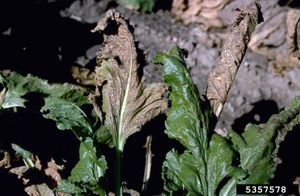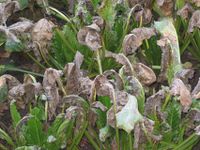Cercospora beticola
| Literature database |
|---|
| 145 articles sorted by: |
| • year (descending) |
| • research topics |
| • countries/regions |
| • host plants |
| • list of antagonists |

Author(s): Howard F. Schwartz, Colorado State University
Source: Wikimedia Commons
Cercospora beticola Sacc. 1876 - (Cercospora leaf spot of beet)
The fungus is wide-spread and causes a serious disease of sugarbeet, especially under warm and humid conditions. The symptoms include circular to oval leaf spots with purple to brown margins and necrotic grey centres where the pseudostromata develop. The spots enlarge, merge and in severe cases can result in the collapse of the whole leaf.
Management typically involves the use of fungicides, but pesticide resistance has been reported. Cultivars with resistance to this disease are known but do not have desirable agronomic traits. The fungus is air-borne and survives in plant debris as stromata or conidia. The conidia are elongated, hyaline, multi-septate, straight or curved with a size of around 100-150 x 4 µm. The tips of the conidia are rounded and the basal cell is truncate with a distinct dark scar.
| Vernacular names | |
|---|---|
| • Deutsch: | Cercospora-Blattfleckenkrankheit der Zuckerrübe |
| • English: | Cercospora leaf spot of beet |
| • Español: | cercosporiosis de la remolacha |
| • Français: | taches cercosporéennes de la betterave cercosporose chez la betterave à sucre |
For a review see Rangel et al. (2020).
- Other images of Cercospora beticola (Wikimedia Commons - click to enlarge)


